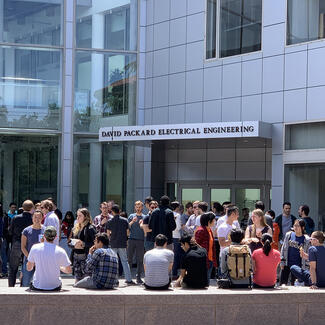
SPECIAL SEMINAR: Single-cavity dual-comb modelocking and applications
SPILKER 232
ABSTRACT: Dual-comb laser sources with two optical frequency combs with different comb spacings and their applications are of high interest for many applications. We describe two breakthrough methods which enables record low-noise single-cavity dual-comb generation with high average power from diode-pumped Yb-doped solid-state lasers and optically pumped semiconductor lasers.
Dual-comb spectroscopy and equivalent time sampling applications are currently limited by the cost, complexity, and size of conventional optical comb systems, based on two modelocked lasers with four active stabilization loops. The single-source dual-comb diode-pumped solid-state and semiconductor lasers, however, substantially reduces the complexity of existing systems to a single compact free-running laser. In comparison to other competing new approaches such as quantum cascade lasers or micro resonator combs, these dual-comb lasers provide substantially more power per comb line with low linewidth and noise, and are ideally suited for a 100 MHz to 5 GHz comb spacing, which is optimal for many applications, allowing for fast, accurate, and sensitive measurements.
This talk explains how measurements with free-running dual-comb lasers without any further active stabilization is possible, how well this works and for what it can be used. Dual-comb laser sources generate two optical frequency combs with different comb spacings and have become a hot topic for many applications. We describe two breakthrough methods which enables single-cavity dual-comb source generation based on polarization [1] and spatial [2] multiplexing.
Polarization multiplexing was first demonstrated with optically pumped vertically emitting semiconductor lasers (VECSELs) which have been successfully modelocked from the visible to the mid-IR spectral range [3]. Continuous-wave operation of these lasers has been successfully commercialized. A modelocked integrated external-cavity surface-emitting laser (MIXSEL) [4] integrates both the gain and the saturable absorber layer within the same semiconductor wafer. The MIXSEL generates a modelocked pulse train from a linear straight cavity defined by the MIXSEL chip and the output coupler as the two end mirrors. In dual-comb operation, the initially unpolarized beam is split towards the semiconductor MIXSEL chip with an intracavity birefringent crystal. This technique was then extended to diode-pumped solid-state lasers [5].
A second approach was invented based on spatial multiplexing by inserting a monolithic device with two separate angles on the surface, such as a biprism [2]. We achieved excellent sub-140 fs and 2.4 W of power per comb operation from an 80-MHz Yb-doped diode-pumped solid-state laser. Furthermore, we have optimized our system for low relative timing jitter between the two pulse trains: we could achieve sub-cycle relative timing jitter for an integration interval of [20 Hz, 100 kHz]. To the best of our knowledge, this is by far the lowest relative timing jitter free-running dual-comb source and we explain how we can measure such low noise [6]. For optical comb line resolved measurements, we believe higher repetition rates are better suited, and we have therefore developed a 1-GHz single-cavity dual-comb laser with sub-100-fs pulses and >900 mW average power per comb more recently. We are able to directly resolve the RF comb lines, and track their phase drifts. By accounting for these drifts, we can coherently average the full interferometric dual-comb signal on long time scales.
No active stabilization is required using our single-cavity free-running dual-comb lasers. Simple stabilization can be achieved in the microwave domain because the SESAM partially decouples the noise between the two combs [7]. We have made the following application demonstrations with our dual-comb sources: optical spectroscopy in the near infrared (IR) [8, 9] and moving towards the mid-IR [10, 11], equivalent time sampling (i.e. standard pump-probe measurements) as demonstrated for SESAM characterization [12], picosecond ultrasonics [13], THz spectroscopy [14] and lidar [15]. Latest lidar results over more than 10-m distance support for a moving target a sub-µm precision with an update rate of 1.7 ms and for a static target a 33-nm precision with an average time of 200 ms [16].
[references available from host]
Bio: Ursula Keller has been a tenured professor of physics at ETH Zurich since 1993 (www.ulp.ethz.ch) and was a director of the Swiss multi-institute NCCR MUST program in ultrafast science from 2010-2022 (www.nccr-must.ch). She received the Ph.D. from Stanford University in 1989 and the Physics "Diplom" from ETH in 1984. She was a Member of Technical Staff (MTS) at AT&T Bell Laboratories from 1989 to 1993, a “Visiting Miller Professor” at UC Berkeley 2006 and a visiting professor at the Lund Institute of Technologies 2001. She has been a co-founder and board member for Time-Bandwidth Products (acquired by JDSU in 2014) and for a venture capital funded telecom company GigaTera (acquired by Time-Bandwidth in 2003). She was a member of the research council of the Swiss National Science Foundation from 2014-2018. She is the founding president of the ETH Women Professors Forum (WPF).
The focus of her group (foto) in research is exploring and pushing the frontiers in ultrafast science and technology (online info). Awards include the Swiss Science Prize Marcel Benoist – the “Swiss Nobel Prize”(2022), OSA Frederic Ives Medal/Jarus W. Quinn Prize (2020) – OSA’s (resp. OPTICA’s) highest award for overall distinction in optics, SPIE Gold Medal (2020) – SPIE’s highest honor, IEEE Edison Medal (2019), IEEE Photonics Award (2018), European Inventor Award for lifetime achievement (2018), two ERC advanced grants (2012 and 2018), member of the U.S. National Academy of Sciences, Royal Swedish Academy of Sciences, German Academy Leopoldina and Swiss Academy of Technical Sciences. She supervised and graduated 91 Ph.D. students (list), published 500 journal publications (list) and according to Google Scholar an h-index of 118 with more than 50’000 citations.